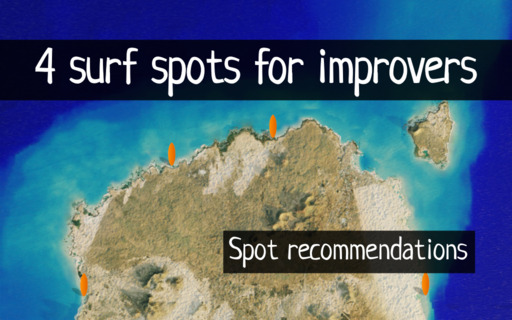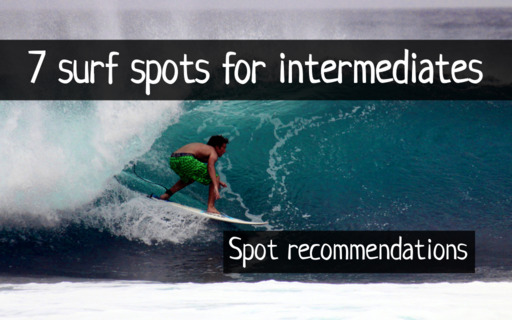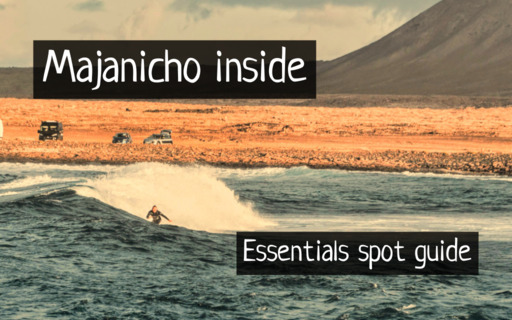Surfing in the land of reef breaks
Fuerteventura North - Surf destination guide
8 minute read. Last update: 2 Jan 2024.
Land of volcanic landscapes, desertic despite the mild temperatures, Fuerteventura has a special place in the heart of many of its visitors. It has a lot to offer to surfers, exposed to the strong swell coming from the North of the Atlantic, and shines particularly with its reef break spots in the North shore.
Contents
Overview
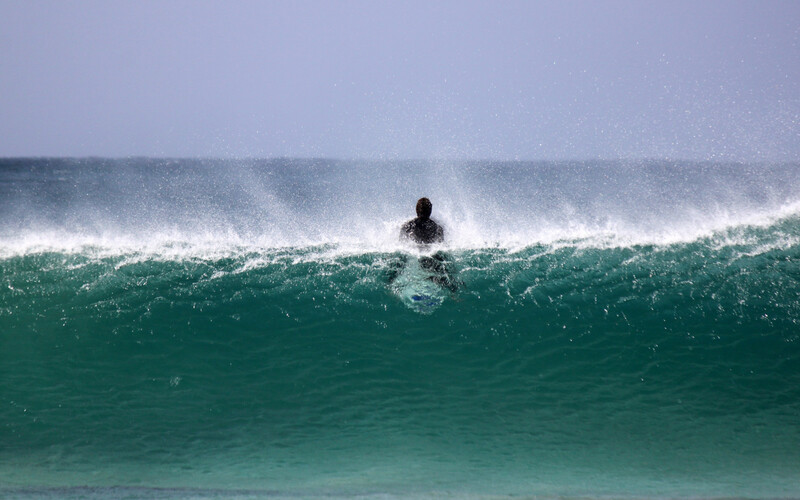
Despite being often windy, Fuerteventura island tends to catch ground swell consistently. And being not so far from continental Europe makes it a popular destination for surf trips.
The North of Fuerteventura is specifically interesting because it gives access to three coasts. Depending on the swell and wind, it is likely that at least one of these will work, and that a surfable spot can be reached in less than 30 minutes drive.
What about the South of the island? Well, while it tends not to get as much swell as the North, some spots have a solid reputation, and is worth checking out. It can be a good alternative to the North, whenever it gets some good swell.
Surf spots
4 surf spots for improvers
Surfing more consistently requires practicing on many waves.
Discover 4 spots perfect for this in Fuerteventura, and which weather conditions is suitable for each of them.
4 Surf spots for improvers7 surf spots for intermediates
As a more experienced surfer, you might be looking for challenging waves with beautiful shoulders and critical sections.
Here are 7 spots where to perfect your art and create unforgettable memories.
7 Surf spots for intermediatesLa Caleta
La Caleta, aka Boneyard, is a small reef break spot with a left-hander waves working well when the swell comes from the North.
The wave has a decent length and offers clean sections for intermediate and advanced surfers.
Visual, one-minute read.
La Caleta Essentials spot guideMajanicho inside
Majanicho inside starts to work with bigger swells. This reef break surf spot is protected, and serves as a fallback spot whenever the waves are very big and powerful.
It features two peaks - a right-hander and an A-frame, suitable to experienced intermediates and advanced surfers.
Visual, one-minute read.
Majanicho inside Essentials spot guidePiedra Playa
Piedra Playa, right in the South of the village of El Cotillo, is a popular beach break spot in the West coast.
It features a steep, fast wave which is fun to ride in small conditions, and tends to close out whenever the surf is big.
Visual, one-minute read.
Piedra Playa Essentials spot guidePunta Blanca
This reef-break spot is popular among improvers, as it tends to always have a wave that breaks.
Often choppy, crowded, some love it, some hate it.
Visual, one-minute read.
Punta Blanca Essentials spot guideSurf forecast locations
The forecast information is presented around four areas, shown below.

Forecast data is provided by the Spanish Agency of Meteorology, which has specific weather prediction models adapted to the region. The waves at the surf spots might be different from what is observed in the weather forecast stations, especially since the measurements are done in the open sea, a few km away from the shore.
We have decided to split the North shore between North-West and North-East because they tend to get different conditions:
- North-West is more exposed to both swells and winds coming from the North.
- North-East might not be reached by Northern swells, given that Lanzarote island is right above. Also, Lanzarote blocks part of the North wind.
Have a look at our surf forecast to figure out the surf conditions today :)
Should you choose Fuerteventura North for a surf trip?
Surf quality
With more than 25 surf spots, Fuerteventura North has unique benefits in the region:
- For advanced surfers: a few world class spots have amazing waves when the conditions are good. During the high season, there is often a consistent swell, with decent wave power. In an conditions, is likely that at least one of the coasts will provide good surf.
- For improvers / intermediates: sets tend to come frequently, providing you with plenty of waves to take. This is a game-changer, allowing you to progress faster.
- For beginners: there is always a spot with good easy waves to practice safely.
Some of the downsides are:
- Spots tend to be crowded, especially during holidays. Checkout our 5 tips for surfing in crowded spots and still have fun in case you tend to get tense when there are many people in the water.
- Fuerteventura North frequently gets strong onshore winds, making the waves pretty choppy.
- Summer is the low season. Very little ground swell comes in. You may get some fun waves from time to time thanks to wind swell, you never know...
Other factors
Here are other practical reasons why you might want to pick Fuerteventura over another place:
- Not so far from Europe, so flights tend to be affordable, and shorter travel times than other destinations like Bali or Costa Rica.
- Overlaps with the Western European time zones, which is convenient for remote workers.
- Mild temperatures all year long, especially interesting in winter time. A 3'2mm wetsuit is sufficient for most people. In summer, a shorty or lycra is definitely an option.
What is the best time to surf in Fuerteventura - seasonality
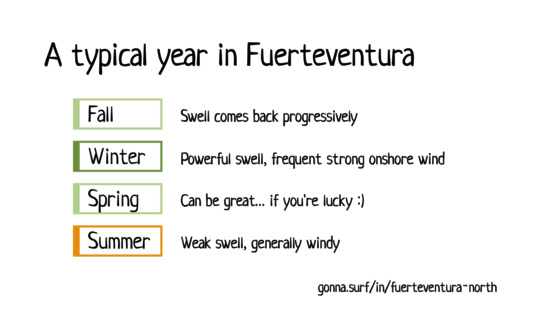
The impact of Azores High
It would be great if it was possible to reliably recommend a month, or even a specific week, when it is almost certain that the weather will be optimal for surfing. While the Canary Islands do get a fair share of quality swell, consistency is not the best.
The high season starts in October, and lasts until April. The Azores High weather phenomenon is responsible of both powerful swell created during winter storms, and strong onshore winds towards the North shore, making the waves choppy.
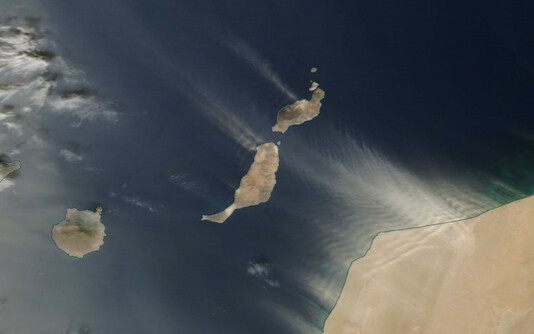
La Calima
On the other hand, La Calima is an occasional dust storm coming from the Sahara, which brings offshore winds to the North and/or the West coasts. La Calima may happen a few times per year, in any season, with varying intensity. When it is too strong, the wind speeds are a bit too high for surfing, and also the quantity of sand in the air makes it difficult to breathe. You can read more about the phenomenon here.
Besides natural conditions, the crowd is another important component affecting the surf experience. The spots are especially overcrowded during the winter and spring holidays.
Where to stay
Surfers have the choice between a few towns and villages to stay during their surf trip. Each has a different vibe.
In general, regardless of where you are staying, it is convenient to have some means of transport to reach the surf spots, as the ones closest to you are not likely to be working... Alternatives: rent a bike with board rack, or take a surf class (transport is provided by the surf schools).
Corralejo
Corralejo is the biggest town in the North of the island, with a population exceeding 28000 inhabitants.
While Fuerteventura does not have the most developed nightlife scene, it offers more options than the other places listed below. The vibe is an eclectic mix of surfers' town and regular tourism.
Walking distance surf spot: Punta Elena and Rocky point. These two spots are accessible on foot for those staying in Fuerteventura. They need a certain swell power in order to work, and can easily get crowded when working.
Lajares
Larajes is a very international village, 40 nationalities being counted within its 3800 inhabitants.
Walking distance surf spot: none. However, Lajares has the advantage to be centrally located between West, North and East shores, providing an easier access to any of which has the best waves...
El Cotillo
El Cotillo, on the West coast, is a originally a fishermen's village. It has a quiet and peaceful vibes, and lays right next to amazing lagoons.
Walking distance surf spot: Piedra playa. A great beach break, mostly good on small days. Waves tend to close out, depending on the movement of the sand banks.
Other locations
Majanicho is a tiny fishermen village right in the middle of the North coast. Super convenient to reach top quality spots around. However, only a few accommodations are available in there. The nearby tourism village Origo Mare can also be an option if you want to be close to the (surf) action.
El Roque
is located
La Oliva and Villaverde are two options a bit further away from the coast, still worth considering.
How to move around - transport
In short:
- Walk if you're staying close to a spot (and the conditions are good there).
- Cycle against the wind if you're feeling adventurous.
- Sit back and relax if you're taking a surf class, as the instructor will drive you to the spot.
- Carpool to enjoy surfing while polluting less.
- Rent a car to have more flexibility.
More details:
Only a few spots can be reached by foot, most of them being at 10 to 35 min drive.
Some surf shops rent bikes with a surfboard rack. This is great when the weather is not too windy. Keep in mind that you'll suffer from the dust flying around while riding on the dirt roads.
If you take surf classes, surf schools will transport you to the surf spot. There are no surf guiding offers in the region.
Most of the roads tend not to be covered with asphalt. These dirt roads can technically be ridden by any type of car, as you'll often see tiny rental fiat 500 or similar vehicles parked in the surf spots. Car rental companies tend not to cover driving on dirt road. Each company has a different policy, and some actually do authorize it (dirt-roads being official public roads, and using them is not driving off-road). Double-check before choosing a car rental company.
We don't have a specific car hire company to recommend. They all tend to be roughly equivalent, being more or less flexible, depending on the season, and possibly the staff member attending to you... One tip: just pay attention to the terms and condition, to be clear on what is included in the price you are paying.
Buses can be used to move between towns, the routes and timetable are available on the bus company's website: tiadhe.com in Spanish, English and German languages.
What should you pack for a surf trip in Fuerteventura - gear
Surf equipment
For those who prefer not to transport their board from home to the island, there is a pretty decent number of surf shops in the area, offering a rather broad selection of boards (both rental, new and second hand).
Wetsuits, booties, other accessories are also generally available.
Most people surf reef without booties, but you might prefer to get some if you are not used to walk barefoot over rocks, or to decrease the risk of injuring your feet.
Clothing
The Canary islands tend to have a mild / warm climate all year long, so you will mostly be wearing some light clothes. However, regardless of the season, always bring a warmer set of clothes with you, as the temperature tends to drop as soon as the sun sets...
In winter, it is possible to get caught in showers. Waterproof clothing can be useful.
Keep in mind that the Canary Islands are in the same latitude as the Sahara. Make sure to remain protected from the sun and to stay hydrated.
Services
Book a surf photographer
Isn't your surf trip worth remembering?
Gonna.surf connects you with photographers active in Fuerteventura North.
Book a surf photoshoot